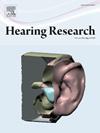耳蜗神经在耳鸣、听觉亢进和恐音症三联网变化中的作用?透视回顾
IF 2.5
2区 医学
Q1 AUDIOLOGY & SPEECH-LANGUAGE PATHOLOGY
引用次数: 0
摘要
耳鸣,没有内部或外部噪声源的声音感知,听觉亢进,对噪音的病理性超敏感,恐音症,对某些日常噪音的不耐受,有什么共同之处,它们的区别是什么?在过去的几十年里,大量优秀的研究集中在识别耳鸣、听觉亢进或恐音症的中枢三网络变化的神经相关性上。在这一观点的回顾中,我们明确地检查,可能的差异和因果参与的外围组件作为一个假定的触发可能驱动观察到的三重网络变化。根据我们的研究结果,我们冒昧地假设:(i)尽管临床上听力阈值正常,耳鸣、听觉亢进和恐音症仍可能发生,并且可能与性别和年龄无关;(ii)耳鸣和听觉亢进,但恐音症也可能与听觉处理的改变有关,听觉处理通过不同步(耳鸣)或过度活跃(听觉亢进、恐音症)自下而上的上升处理可能解释了例如默认或突出的大脑网络的活动变化。正如对这些不同疾病的各种研究所表明的那样。(三)在恐音症中,一种由压力引起的自上而下的影响,与听觉神经纤维一样深,可以作为产生恐音症触发声音的一个因素加以讨论,这一假设可以在未来的研究中加以验证。我们希望有选择性地考虑外周和中枢成分之间可能的相互作用,将有助于最大限度地减少迄今为止这些病理对成功治疗的最大障碍:缺乏对疾病潜在致病机制的澄清。本文章由计算机程序翻译,如有差异,请以英文原文为准。
Cochlear neural contributions to triple network changes in tinnitus, hyperacusis & misophonia? A perspective review
What do tinnitus, the perception of sounds without an internal or external source of noise, hyperacusis, the pathological hypersensitivity to noise, or misophonia, an intolerance to certain everyday noises, have in common, and what differentiates them? A large number of excellent studies focused in the last few decades on identifying the neural correlates of tinnitus, hyperacusis, or misophonia on the basis of central triple-network changes. In this perspective review we explicitly examine, possible differential and causal involvement of peripheral components as a presumptive trigger that may drive observed triple-network changes. Based on our results, we venture to hypothesize that: (i) tinnitus, hyperacusis, and misophonia can occur despite clinically normal hearing thresholds, and are likely causally independent of sex and age, (ii) tinnitus and hyperacusis, but possibly also misophonia are related to altered auditory processing that through desynchronized (tinnitus) or hyperactive (hyperacusis, misophonia) bottom-up ascending processing potentially explains the activity changes in, e.g., default or salient brain networks, as suggested in various studies of these different diseases. (iii) In misophonia a stress-induced top-down influence, as deep as the auditory nerve fibers, may be discussed as a contributor to generating misophonia-trigger sounds, a hypothesis that can be tested in future studies. We hope that the selective consideration of a possible interaction between peripheral and central components will help to minimize the greatest handicap of these pathologies to date towards successful therapy: the lack of clarification of the underlying causative mechanism of the diseases.
求助全文
通过发布文献求助,成功后即可免费获取论文全文。
去求助
来源期刊

Hearing Research
医学-耳鼻喉科学
CiteScore
5.30
自引率
14.30%
发文量
163
审稿时长
75 days
期刊介绍:
The aim of the journal is to provide a forum for papers concerned with basic peripheral and central auditory mechanisms. Emphasis is on experimental and clinical studies, but theoretical and methodological papers will also be considered. The journal publishes original research papers, review and mini- review articles, rapid communications, method/protocol and perspective articles.
Papers submitted should deal with auditory anatomy, physiology, psychophysics, imaging, modeling and behavioural studies in animals and humans, as well as hearing aids and cochlear implants. Papers dealing with the vestibular system are also considered for publication. Papers on comparative aspects of hearing and on effects of drugs and environmental contaminants on hearing function will also be considered. Clinical papers will be accepted when they contribute to the understanding of normal and pathological hearing functions.
 求助内容:
求助内容: 应助结果提醒方式:
应助结果提醒方式:


